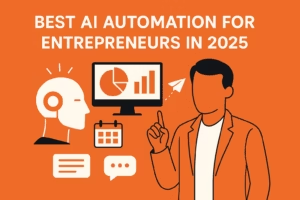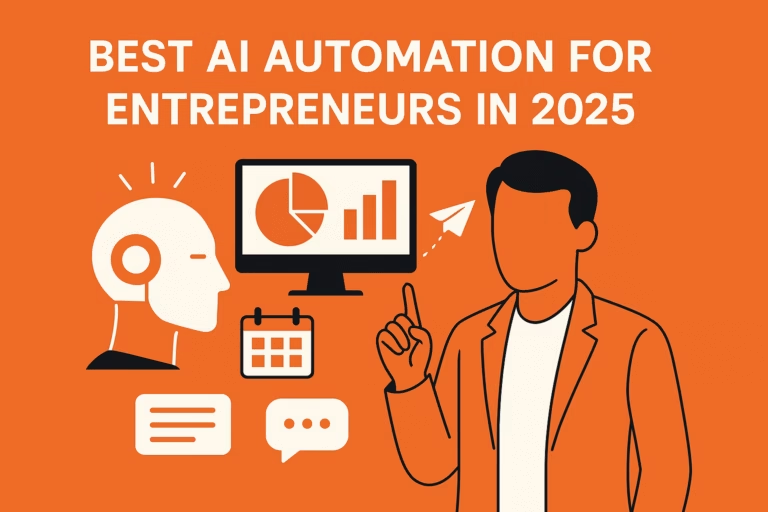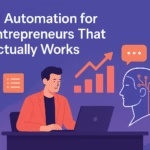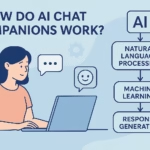Key Takeaways
- AI automation for entrepreneurs turns consistency into scale — it replaces effort with structure.
- The best systems connect marketing, analytics, and communication in one hub.
- Automation saves time but still needs your voice; keep reviewing and refining output.
- Track impact using five core metrics: time saved, output, speed, engagement, and revenue.
- Start small, iterate weekly, and let the system evolve into your biggest competitive edge.
Most entrepreneurs in 2025 aren’t failing because they lack effort. They’re failing because they still work like it’s 2019. They post by hand, track analytics manually, and spend hours managing tools that barely connect. Meanwhile, competitors are scaling faster with half the effort.
That’s where Blaze Autopilot changes everything. It brings the best of AI automation for entrepreneurs into one system that plans, publishes, and optimizes your content automatically. It’s what allows small teams to run like agencies and solo founders to finally step away from their screens.
The truth is, the best automation in 2025 isn’t loud. It doesn’t flood you with features or dashboards. It’s quiet, predictable, and almost invisible. The kind of efficiency that feels like time bending in your favor. This guide shows exactly how that happens and how you can build it into your own workflow.

The 2025 Shift — From Hustle to Systems
The entrepreneurial myth of “work harder, sleep later” finally broke. The real currency in 2025 is consistency showing up every day without burning out. Hustle once meant success, but now it’s a red flag that your system is broken.
Founders who adapted early made a different move: they built infrastructure. They didn’t hire more people; they designed smarter loops. AI now handles repetitive work like content scheduling, data entry, and campaign testing. The entrepreneur’s new job is oversight, not overload.
That mindset shift from performer to architect defines who wins this decade. You don’t need more hours. You need systems that never clock out.
The Three Pillars of Effective AI Automation
The best AI automation for entrepreneurs rests on three foundational pillars: visibility, intelligence, and execution.
1. Visibility
AI keeps your brand in front of the audience at the right time, on the right channel, with the right message. It manages cadence, tone, and delivery without missing a beat.
2. Intelligence
Automation gets smarter every week. It measures engagement, predicts timing, and adjusts creative choices automatically. The more you use it, the sharper it gets.
3. Execution
Execution is where systems turn thinking into motion. AI publishes, replies, and reports instantly, syncing across platforms while you focus on growth strategy.
Together, these three form a living loop — visibility brings data, intelligence interprets it, and execution compounds results. When done right, your brand becomes self-sustaining.
Top Use Cases of AI Automation for Entrepreneurs in 2025
The best AI automation for entrepreneurs works where time leaks fastest. Think about your week. How many hours go into posting, replying, and following up instead of strategizing or selling? Automation plugs those gaps by turning repetitive work into background processes that never forget.
Content Creation and Repurposing
You write one post and AI instantly adapts it for LinkedIn, email, and short-form video scripts. Instead of publishing once, you publish everywhere. The system tracks engagement and tweaks tone over time, learning what resonates.
Lead Management
When a new lead comes in, AI qualifies it, sends a tailored reply, and follows up automatically. No more sticky notes or missed opportunities. It’s your personal assistant that never needs reminders.
Customer Support
AI can respond to FAQs, schedule calls, or summarize feedback while you sleep. The experience feels faster and more personal because response time drops to seconds.
Finance and Reporting
Automated dashboards update numbers daily and create weekly summaries you can act on. You see patterns instead of piles of data.
Market Research
AI scans competitors, reviews, and industry chatter to show what’s trending before it’s obvious. Your strategy starts to feel predictive instead of reactive.
Each use case reclaims hours. Stack them together, and you buy back entire days.
The Mistake Most Founders Still Make
Even with the rise of AI automation for entrepreneurs, many founders still get stuck. The reason is simple: they chase tools instead of systems. They subscribe to every new AI app and end up with ten tabs open and no real progress.
Automation isn’t about collecting software. It’s about connecting the right few. The best founders use one hub that handles content, analytics, and communication in sync. Everything else is noise.
Another trap is automating chaos. If your process is messy, AI will make it worse. Before adding automation, clean up your workflow. Map what happens first, what triggers next, and what needs approval. Then automate from that blueprint.
The last mistake is forgetting the human layer. Automation handles consistency, not creativity. Your voice, judgment, and empathy still matter. The winning setup blends machine precision with human insight.
Automation doesn’t replace work; it upgrades it. Founders who get that balance right scale faster and sleep better.
The Role of AI Assistants and Autopilots
A few years ago, automation meant scheduling posts or sending emails at set times. Now, AI automation for entrepreneurs has evolved into full autopilot systems that learn and adapt. The difference is night and day. Instead of following rigid rules, these assistants make decisions based on data, tone, and timing.
This is where tools like Blaze Autopilot stand out. It’s not a cluster of disconnected features. It’s a single, coordinated system that creates, publishes, and measures performance automatically. You feed it ideas and goals, and it translates them into content, campaigns, and reports that feel tailored to your brand.
It’s the invisible employee that never takes a break. For solopreneurs, it’s leverage; for teams, it’s scale. The smartest founders in 2025 aren’t managing ten tools — they’re running one system that manages ten workflows. That’s the real promise of AI in entrepreneurship.
Comparison: Manual vs Automated Workflows
To understand how deep the change runs, compare a typical manual workflow with a fully automated one.
Manual Workflow
A founder brainstorms ideas, writes a post, designs a graphic, uploads to each platform, tracks comments, and compiles performance data into a report. Each step eats time. It’s reliable, but painfully slow.
Automated Workflow
AI takes the idea, drafts content, formats it for each platform, schedules posts, tracks engagement, and generates a weekly summary. You spend minutes on approval and strategy instead of hours on maintenance.
The results aren’t subtle. Publishing frequency doubles. Response time drops. Analytics finally make sense because the data flows in real time.
This is what separates static brands from scalable ones. Manual workflows rely on effort. Automated workflows rely on design. In 2025, design wins every time.
The Role of AI Assistants and Autopilots
In 2025, AI automation for entrepreneurs isn’t about having a collection of tools; it’s about running a system that thinks. Old-school automation followed static commands — “post this at 9 a.m.” New systems adapt, analyze, and optimize every cycle, learning your business rhythm.
That’s where Blaze Autopilot comes in. It brings everything under one roof: content creation, scheduling, analytics, and reporting. You type one idea, and the system drafts, posts, and studies its own results. It’s not replacing human creativity; it’s amplifying it.
For solopreneurs, it acts as a full marketing team. For growing startups, it becomes an internal engine that scales output without hiring more staff. The difference is in design — instead of ten disconnected apps, you get one clean ecosystem that runs itself.
This is what an autopilot feels like in business: quiet precision that frees you to lead instead of chase notifications.
Manual vs Automated Workflows
Here is a clear view of how AI automation for entrepreneurs changes daily operations from effort driven tasks to system driven outcomes.
| Process Step | Manual Workflow | AI Automated Workflow |
|---|---|---|
| Content Creation | Write each post from scratch | Generate multiple drafts from one idea |
| Design and Formatting | Apply templates per platform | Auto format for each channel |
| Scheduling | Upload and time posts individually | Schedule across platforms in one action |
| Engagement Tracking | Check analytics manually | Track in real time with adaptive timing |
| Performance Reports | Compile spreadsheets weekly | Auto generate summaries and insights |
Automated workflows increase publish velocity, reduce response time, and provide clean feedback loops that guide the next move.
The One-Hour Setup Blueprint
Most entrepreneurs overcomplicate automation. They imagine it needs coding skills or a week of tutorials. The truth is, you can build a working foundation of AI automation for entrepreneurs in under an hour if you move in the right order.
Follow this blueprint:
Step 1. List repetitive tasks.
Write down everything you do more than twice a week — posting, replying, reporting, or designing. Those are your automation candidates.
Step 2. Pick three quick wins.
Start where frustration is highest. Automate those first. The early results will fuel momentum.
Step 3. Link your ecosystem.
Connect your social accounts, email list, and analytics tools to one hub. Every click you eliminate adds minutes back to your day.
Step 4. Create your voice profile.
Teach your AI how you speak. Feed it examples of past captions, headlines, and tone. This prevents your automation from sounding generic.
Step 5. Test and tweak weekly.
Automation isn’t a one-time setup; it’s a living system. Check analytics, adjust prompts, and cut what doesn’t deliver measurable time savings.
Within a few hours, your system will start running small loops of automation that free you to plan instead of react. In a month, those small loops form a rhythm that quietly powers your entire business.
Metrics That Prove Automation Works
Measure what matters so you know your system is saving time and driving real outcomes. Keep the tracking simple and consistent each week.
| Metric | Why It Matters | What to Watch |
|---|---|---|
| Time Saved | Shows efficiency gains from automation | Compare average task duration before and after setup |
| Output Velocity | Reveals how much work ships each week | Track post count, campaign completion rate, deliverables sent |
| Response Speed | Reflects how fast leads and clients hear back | Average reply time, follow up gap, first touch within one hour |
| Engagement Rate | Confirms that automation stays human and relevant | Comments, shares, saves, dwell time, click through |
| Revenue Impact | Connects automation to business growth | Lead conversion, booked calls, sales lift versus baseline |
Track five numbers weekly. If time saved and consistency rise together, keep scaling. If output rises while engagement falls, refine prompts and voice guidelines until quality and volume align.
Real Examples from the Field
The best proof that AI automation for entrepreneurs works doesn’t come from theory. It comes from founders who built systems that now run quietly in the background while they focus on growth.
Case 1: The Agency Owner
A solo marketer turned her three biggest clients into fully automated accounts. Her system now generates weekly performance reports, posts content across six platforms, and sends client updates automatically. She cut admin time by twelve hours a week and redirected that time into pitching new business.
Case 2: The E-commerce Seller
Before automation, his weekends disappeared into writing product descriptions and emails. After integrating an AI autopilot, his store now updates copy, schedules flash sale emails, and monitors conversions. Repeat purchase rates jumped by thirty percent in three months.
Case 3: The Consultant
He used AI to record and summarize client calls, auto-draft proposals, and schedule follow-ups. The system reduced proposal turnaround from three days to half a day. That speed alone doubled his close rate.
Each case shares the same DNA: a simple, connected system that works on its own. Once it’s running, the founder’s role shifts from doing to deciding — the mark of real leverage in 2025.
What’s Next: Predictive Automation in 2025
What’s happening right now is just the first layer. The next wave of AI automation for entrepreneurs won’t just respond — it will predict.
Here’s what’s coming:
- Predictive content engines. They’ll post at the moment your audience is most likely to engage, adjusting tone and visuals in real time.
- Voice-controlled dashboards. You’ll run campaigns by talking instead of typing. Imagine saying, “Plan a three-post launch for next Friday,” and watching it happen.
- Adaptive budgeting. AI will shift your ad spend daily toward the best-performing platforms without manual input.
- Self-learning customer journeys. Your system will detect buying intent and trigger customized experiences instantly.
The gap between early adopters and everyone else will widen fast. Those who build systems now will have data advantage later. The future isn’t about keeping up — it’s about staying ahead by teaching your automation to anticipate what’s next.
In the near future, your business won’t just work automatically; it will think automatically.
Winding Up
Every founder dreams of freedom, but few build it into their systems. AI automation for entrepreneurs isn’t just about working faster; it’s about removing friction until your business starts to breathe on its own. The goal isn’t to escape work — it’s to focus on the work that matters.
The tools now exist to make that happen. With automation handling the routine, you can think about partnerships, products, and strategy instead of checklists. You stop chasing time and start directing it.
The quiet truth about 2025 is that the gap between “busy” and “scaling” is smaller than ever. It’s measured in who embraced automation and who hesitated. Those who built systems early are already free to think bigger. Those still clinging to manual workflows will always feel behind.
You don’t need to go all in overnight. Start small. Pick a few processes, automate them well, and expand from there. When the system finally clicks — when it starts running in the background without you — that’s not luck. That’s leverage.
FAQs
1. What’s the first thing I should automate as an entrepreneur?
Start with tasks you repeat daily, like posting content or replying to common messages. These give you instant time savings and visible results.
2. How do I make sure AI doesn’t sound robotic?
Feed it examples of your tone. Use old emails, posts, or chat replies to train it on how you naturally speak. Keep reviewing outputs weekly until it matches your style.
3. Can automation replace a full marketing team?
It can replace the repetitive work, not the creative thinking. The best results happen when humans handle the ideas and AI handles the execution.
4. Is AI automation expensive to start?
Not anymore. Most systems are subscription-based, and many scale with your business. What matters more is setup — building smart workflows around what you already do.
5. How often should I review my automation setup?
Every two weeks at first, then monthly. Automation evolves as your business grows. Regular review keeps it relevant and effective.



